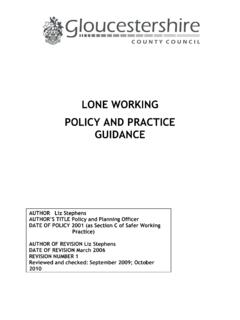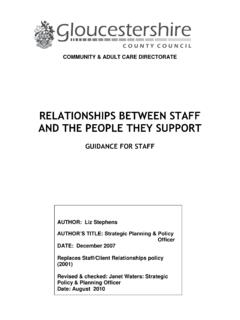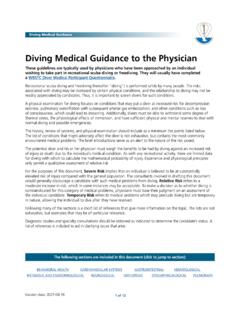Transcription of Promoting Choice: Positive Risk Management
1 Promoting choice : Positive Risk Management Document reference: GCC_ASC_POL_006. Version: Ratified by: Adult Senior Management Team Date ratified 18 December 2014. Originator/author: Policy Reviewing Officer Responsible committee/individual: Adult Social Care Executive lead: Head of Adult Social Care Date issued: December 2014. Review date: December 2017. THIS IS A CONTROLLED DOCUMENT. Whilst this document may be printed, the electronic version maintained on the GCC intranet is the controlled copy. Any printed copies of this document are not controlled. It is the responsibility of every individual to ensure that they are working to the most current version of this document. 1. S. Morgan practice development consultant in Risk-making or risk-taking? Open Mind 101, 2000. Promoting choice : Positive Risk Management Page 1 of 18. Promoting choice : Positive Risk Management Contents Page 1 Policy Statement 3.
2 2 Purpose 3. 3 Scope 3. 4 Definitions 4. 5 Context 4. 6 What is Risk? 5. 7 What is Positive Risk Management ? 6. 8 The mental capacity Act 2005 7. 9 The Human Rights Act 9. 10 Public Sector Equality Duty 9. 11 Mandatory Procedures 10. Identification, assessment and Management of Risk 12 The 4 Stages of Positive Risk Management 11. Risk Identification Risk assessment Support Positive Risk Management On-going Management of Risk 13 Disputed Support Plans and the Risk Management Escalation 16. Process 14 Review of Incidents 17. 15 Implementation 18. 16 Monitoring and Review 18. 1. S. Morgan practice development consultant in Risk-making or risk-taking? Open Mind 101, 2000. Promoting choice : Positive Risk Management Page 2 of 18. Promoting choice : Positive Risk Management 1. Policy Statement There are fundamental principles, which underpin Gloucestershire County Councils corporate governance arrangements.
3 Principle 4 is Taking informed and transparent decisions, which are subject to effective scrutiny and managing risk . This policy contributes to ensuring there is an effective risk Management system in place for adult social care and that we are maximising opportunities by enabling individuals to take managed risks . The introduction of self directed support with the emphasis on people having more choice about how their needs are met makes it all the more essential that we work with individuals and their families to ensure risks are identified, quantified, discussed and managed. We need to ensure we support people and enable them to take risks that are reasonable, because of the benefits they bring, but balance this with our duty to ensure that vulnerable people are protected from exploitation or abuse. 2. Purpose This policy seeks to demonstrate how the assessment and support planning processes and Face tools should be practiced and used to promote a Positive approach to risk Management that ensures the requirements of health and safety legislation, care standards and Safeguarding Adults policies are not compromised.
4 Finding Positive ways to manage risks will support our approach to prevention, early intervention and self-directed care. As a Health and Social Care provider we need to proactively collaborate with people and their carers to empower them to make choices, while supporting them to take informed everyday risks . 3. Scope This policy applies to: All staff working in adult social care All staff delivering a service to a GCC adult social care customer Independent providers that are commissioned by Gloucestershire County Council to provide social care services Independent providers that are commissioned directly by people who have been allocated a personal budget and are using a direct payment. 1. S. Morgan practice development consultant in Risk-making or risk-taking? Open Mind 101, 2000. Promoting choice : Positive Risk Management Page 3 of 18.
5 4. Definitions DoH Department of Health FACE Functional assessment of the Care Environment Gloucestershire's Overview assessment recording tool FACS Fair Access to Care Services Hazard - A hazard is anything with the potential to cause harm. HSE Health and Safety Executive who are responsible for enforcing health and safety legislation. IMCA Independent mental capacity Advocate Risk A risk is likelihood that a hazard will cause specific harm to someone or something. SHE unit Safety, health and environment unit of Gloucestershire County Council 5. Context For the purpose of this policy most of the risks referred to arise from how we meet social care needs: A Vision for Adult Social Care: Capable Communities and Active Citizens 2010 DH. Our health, our care, our say 2006 DH. Independence, choice and risk 2007 - DH. Safety legislation and guidance applies to support plans to ensure the safety of people, carers and staff.
6 The Health and Safety at Work Act 1974 This act sets out employers'. responsibilities for the health and safety of their employees and others, as well as responsibilities employees have to themselves and each other. Management of Health and Safety at Work Regulations 1999 These regulations require employers to carry out a suitable and sufficient risk assessment of the work related risks to employees and others. 1. S. Morgan practice development consultant in Risk-making or risk-taking? Open Mind 101, 2000. Promoting choice : Positive Risk Management Page 4 of 18. Manual Handling Operations Regulations 1992 (amended 2002) These require a risk assessment when any of a wide range of manual handling activities of inanimate objects or persons are involved. 6. What is Risk? Risk can be defined as: The chance of something happening or not happening that will have an impact, either negative (threat) or Positive (opportunity), upon the achievement of objectives.
7 It is measured in terms of likelihood and impact.. An event can occur because of: risks associated with impairment or disability such as falls Accidents, for example, whilst out in the community, during travel to activities, clubs, education establishments, or at a social care service risks associated with everyday activities that might be increased by a person's impairment or disability Non-compliance in the use of medication The misuse of drugs or alcohol Behaviours resulting in injury, neglect, abuse, and exploitation by self or others Suicide or self-harm Aggression and violence The type of event depends on the nature of the person, their relationships with others and the circumstances they find themselves in. Risk is often thought of in terms of danger, loss, threat, damage or injury. But as well as potentially negative characteristics, risk-taking can have Positive benefits for individuals and their communities.
8 The difference for many disabled adults and older people with additional needs when they take risks is that they will do so when being supported by personal assistants or a support worker from a statutory service or an independent agency. Also, there will be times when a disabled or older person might take 1. S. Morgan practice development consultant in Risk-making or risk-taking? Open Mind 101, 2000. Promoting choice : Positive Risk Management Page 5 of 18. risks on their own, but a statutory service might be held responsible if harm to them or others occurs. A balance therefore has to be achieved between the desire of disabled adults and older people to do everyday activities, the duty of care owed by services and employers to their workers, and the legal duties of statutory and community services and independent providers. As well as considering the dangers associated with risk, the potential benefits of risk-taking have to be identified ( nothing ventured, nothing gained').
9 This should involve everyone affected . adults who use services, their families and practitioners. 7. What is Positive Risk Management ? Risk is often perceived in terms of danger, loss, threat, damage or injury but as well as these negative aspects; it can also have Positive benefits for individuals and their communities. Steve Morgan defines Positive risk Management as: Weighing up the potential benefits and harms of exercising one choice of action over another (by) Identifying the potential risks involved, and developing plans and actions that reflect the Positive potentials and stated priorities of the service user. It involves using available resources and support to achieve the desired outcomes. It is not negligent ignorance of the potential is usually a very carefully thought out strategy for managing a specific situation or set of circumstances.
10 1. In reality this means for staff: Being empowering and person centred Working in partnership with people, carers and advocates Making sure the individual's voice is heard Developing an understanding of the responsibilities of each party Helping people and their carers to access opportunities and take worthwhile chances Developing trusting working relationships Helping people who use/ purchase services to learn from their experiences Understanding the consequences of actions Making decisions based on all the choices available and accurate information Being Positive about potential risks when Promoting independence Understanding a person's strengths, skills and abilities Knowing what has worked or not in the past Where problems have arisen, understanding why Ensuring support and advocacy are available to those people who are vulnerable or perceive themselves to be vulnerable.














